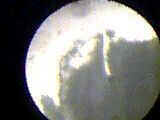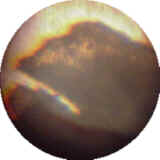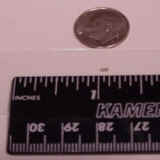

|
|
||||
Alien and UFO ResearchPossible Alien Implant Analyzed
AAER received a possible alien implant from one of our regular correspondents in Ontario, Canada. The man remembers the abduction which occurred the night of July 1, 1999. During the abduction, the aliens told the man they were giving him a gift, which was the implant. In the morning, the man dug the implant out of his chin and sent it to us for analysis. This is the microbiologist's report of the specimen. Photos and tables are included with the report. The specimen was received from AAER on
July 29, 1999. It consisted of a whitish-clear
flat substance about 2 x 2 mm in size.
Examination with a Geiger counter showed no
significant radioactivity over background and it
was not florescent upon exposure to UV light. The specimen was analyzed by scanning electron
microscopy (SEM), and during the mounting process
it fragmented into several pieces. Several
photographs were taken which included parts of
one or more of three fragments. See Figurewww.abduct.com/research
1, Figure
3. The
observed pieces represent elongated components
that evidently had been arranged parallel with
each other and adhered together. One of the
fragments appears to have a cylindrical structure
approximately 100 microns in diameter but with
some variation depending on the region. See Figure 5 100x Power
This is a closeup of the left side of the above
specimen showing cylindrical structure. Photo by
AAER.
This is a closeup of the specimen not magnified.
It is horizontal to the coin and the ruler. Photo
by AAER.
When the SEM was configured for EDS (energy
dispersive spectroscopy) analysis to determine
elemental content, we were able to detect carbon
(C), oxygen (O), sulfur (S) and a calcium (Ca).
Carbon was the most predominant with sulfur
having the next highest concentration. Oxygen was
about half the level of the sulfur, and calcium
was the lowest of the four (Figure
6).
Scanning of a broader area of the sample gave
similar results but revealed, in addition, small
amounts of sodium (Na), chlorine (Cl) and
potassium (K) (Figure 7). Assuming the sample
is organic, it probably also contains a
significant amount of hydrogen, which is too
light an element to be detected. Conclusion: The sample appears to be an organic
substance with primary detectable elements
corresponding to carbon, oxygen, and sulfur. Its
identity and possible function remain unknown at
this time. |
Alien Abduction Experience and Research
Copyright ©1996 - 2019. All Rights Reserved.


